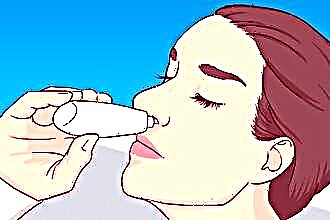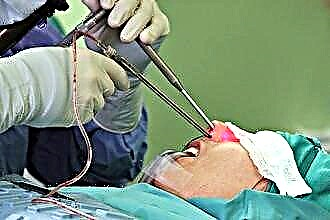Normally, to provide all organs and tissues with oxygen, the left ventricle pushes blood into the aorta, from where it diverges through the body due to the operation of the valve. If the cusps of the latter do not close completely, some of the blood returns back to the heart during diastole, causing left ventricular overflow. This situation is called aortic valve insufficiency.
Causes and types of vice
There are two types of diseases that differ in origin: congenital and acquired. Insufficiency of the aortic valve in children is most often formed during the period of intrauterine laying of organs and systems. The reasons for the violation of the development of the valves are a genetic defect or the effect of some substances on the fetus.
The acquired form of the defect occurs under the influence of the following factors:
- Infections (tonsillitis, sepsis, syphilis). Inflammation of the endocardium occurs with damage to the valve apparatus.
- Rheumatism. The mechanism of development consists in the appearance of growths and thickenings on the valves, which prevents them from closing tightly. According to my observations, more than 85% of all patients with mitral or aortic defects have positive rheumatic tests.
- Other reasons. Somewhat less often, etiological factors are lesions of the aorta atherosclerosis, dissecting aneurysm, Marfan syndrome, or chest trauma.
Insufficiency of the aortic valve in its pure form remains a compensated defect for a long time. But over time, left ventricular hypertrophy develops, and signs of pronounced hemodynamic disturbances appear.

Symptoms
The disease manifests itself in different ways depending on the degree of neglect of the pathology. For comparison, you can give a table of signs of the disease by stages:
| Stage | Regurgitation degree in% | Complaints | Signs on examination |
| I. Full compensation | 15 | absent | no deviations, the appearance of a slight noise at the time of diastole during auscultation |
| II. Aortic insufficiency grade 2 (latent) | 15-30 | the appearance of discomfort behind the sternum after physical exertion, throbbing in the head and neck, palpitations | increased heart rate |
| III. Subcompensation | 50 | pain syndrome of the type of angina at rest, dizziness, tinnitus, visual impairment, fainting, head shaking, pulsation of the pupils and vessels of the nail bed | enlargement of the liver, pasty legs, pallor, jumping pulse, weakening of I and II tones, an increase in the difference between systolic and diastolic pressure |
| IV. Decompensation | from 50 and more | progressive failure, dysfunction of all organs, arrhythmia, severe edema | acrocyanosis, anasarca, hepatosplenomegaly, uneven pulse, visual definition of a heart beat, its displacement to the 7th intercostal space |
The compensatory stage can last for a long time, without manifesting itself, if the cause is a chronic process.
Diagnostics
To clarify the diagnosis, a number of instrumental studies are required:
- On the roentgenogram, symptoms of aortic insufficiency appear as an increase in the left and right ventricles.
- The cardiogram shows signs of an increase in the left ventricle, tachycardia and ectopic rhythm from the bundle branch. After exercise, ST segment depression begins, and other symptoms of myocardial ischemia appear.
- When conducting phonography, diastolic murmur is detected as a result of blood regurgitation in the left ventricle and III tone due to vibrations of its walls. Systolic murmur is formed due to turbulence of blood flow through the modified leaflets.
- Echocardiography determines the violation of the structure of the valves, hypertrophy of the left myocardium, flutter of the mitral valve.
Modern treatments
The initial stage of pathology does not need special treatment. The patient should regularly visit a cardiologist (once every 6 months), undergo EchoCG, ECG and other additional diagnostic methods, if indicated. A person is recommended to reduce physical activity, and in case of rheumatism - taking antibiotics and refusing to stay in conditions of increased dampness.
With the development of the first symptoms at the stage of relative compensation, treatment consists of using diuretics, antihypertensive drugs, and taking antibacterial agents in order to prevent infectious complications. The medical method of providing assistance cannot completely eliminate the problem, but only acts on the cause and improves the quality of a person's life.
Types of prostheses and the difference between them
Plastic or replacement of the valve and the ascending part of the aorta is recommended at the stage of the beginning of hemodynamic decompensation. Also, an emergency operation is performed in case of an acute aneurysm or valve damage with a strong blow to the chest.
Surgical treatment of aortic valve insufficiency is usually performed using artificial and biological implants. The former are made from metals with an intact coating, while the latter are divided into three types:
- xenografts (created from animal tissue);
- homografts (other person's material is used);
- autografts (taken from the operated person).
Previously, all operations were performed on an open heart. Currently, transcatheter implantation is being practiced. This is a minimally invasive technique that involves placing an artificial valve through a hole in a vessel without incising the chest.
There are several types of prostheses on the market for such an operation:
- Medtronic CoreValve. Inserted transfemorally (through the femoral artery), consists of a frame and three valves, which are produced from the porcine pericardium.
- It is placed by the method of transapical access (through the apex of the heart).
- It is made of a bull's pericardium, and a stainless steel ring is used as an attachment.
After a week in the hospital, the person is discharged under the supervision of their doctor. Sometimes the hospital stay is extended up to 10 days.
Basic rehabilitation consists in correctly selected medication support, which will prevent possible complications and accelerate the process of returning a person to a normal lifestyle. The treatment protocol in this case includes the following groups of drugs:
- immunosuppressants are necessary to suppress the process of graft rejection;
- antibiotics prevent infectious complications;
- anticoagulants prevent blood clots on artificial valves
- antiplatelet agents that thin the blood.
The patient's medical treatment after surgery will include drugs to treat conditions that have caused the defect or aggravated the course of the disease.
Prognosis: how aortic regurgitation affects life expectancy
The prognosis for aortic valve insufficiency depends on the volume of blood returned to the left ventricle. At the stage of relative compensation, life expectancy is 5-10 years. In the presence of severe edema and other symptoms of circulatory disorders, all treatment and prevention measures can be provided in the region of 2 years, if surgical intervention is not performed for one reason or another. In this case, the patient is assigned a disability, and therapy is given to alleviate the symptoms.



